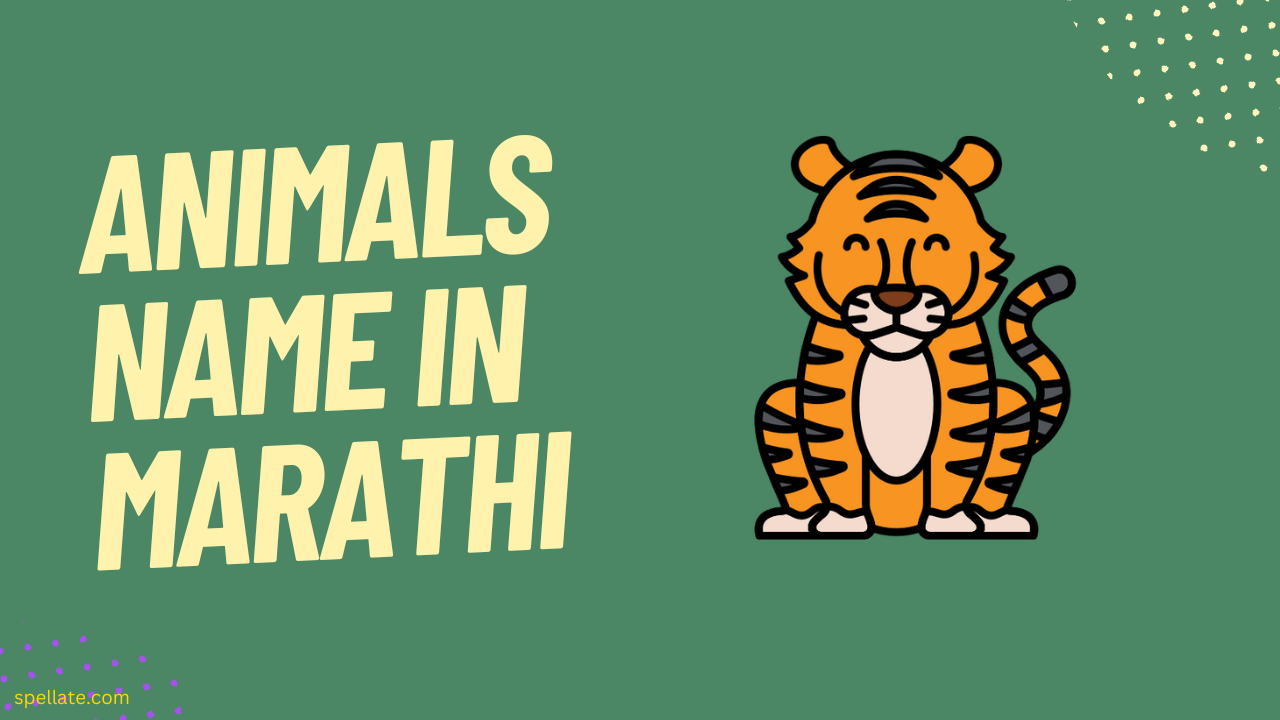Marathi, one of the prominent languages spoken in the western Indian state of Maharashtra, has a beautiful and diverse vocabulary when it comes to describing the animal kingdom. Maharashtra’s geographical diversity, ranging from coastal regions to lush forests and arid plateaus, has contributed to a wide variety of native wildlife that has found a place in the hearts of Marathi speakers.
From the regal Royal Bengal Tiger to the graceful Indian Peafowl, and from the mighty Indian Elephant to the elusive Indian Leopard, Marathi boasts a collection of names that reflect the intriguing wildlife inhabiting this fascinating region. Whether you are a language enthusiast, a nature lover, or someone curious about Maharashtra’s wildlife, this guide on “Animals Name in Marathi” will take you on a journey through the linguistic marvels that depict the enchanting creatures residing in the state.
Join us as we explore the captivating world of Marathi animal names, dive into their cultural significance, and appreciate the conservation efforts taken to protect these precious species. Get ready to embark on an exciting adventure that combines language, culture, and wildlife, celebrating the unique bond between humans and animals in Maharashtra.”
- Popular Animals name in Marathi
- 1. Tiger – वाघ (Vagh)
- 2. Lion – सिंह (Singh)
- 3. Elephant – हत्ती (Hatti)
- 4. Deer – हिरन (Hiran)
- 5. Monkey – माकड (Makad)
- 6. Cow – गाय (Gay)
- 7. Dog – कुत्रा (Kutra)
- 8. Cat – मांजर (Manjar)
- 9. Horse – घोडा (Ghoda)
- 10. Peacock – मोर (Mor)
- 11. Crocodile – मगर (Magar)
- 12. Buffalo – म्हैस (Mhais)
- 13. Rabbit – ससा (Sasa)
- 14. Snake – साप (Sap)
- List of 40 animals names in Marathi
Popular Animals name in Marathi
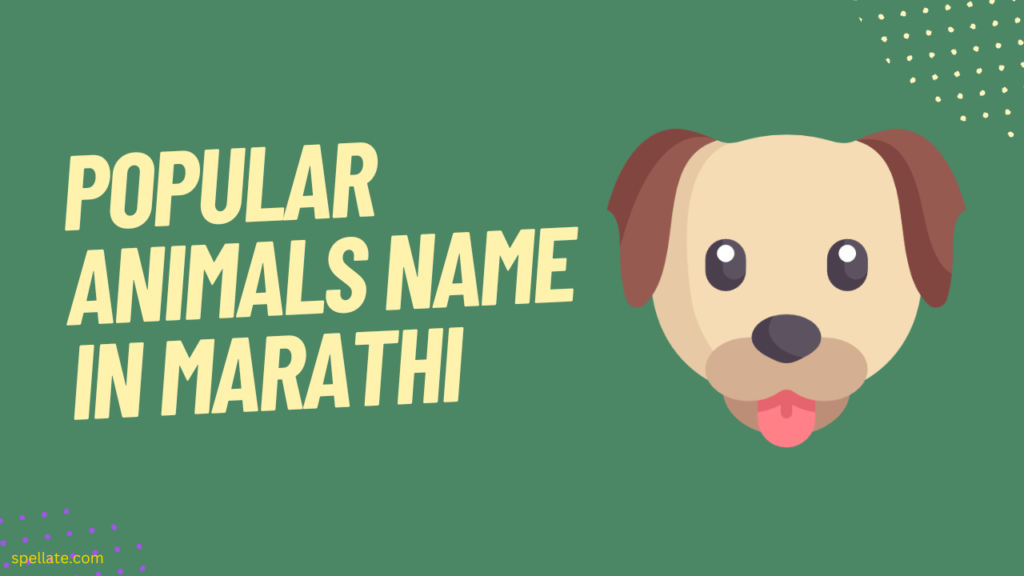
It is fascinating to witness the cultural diversity reflected in animal names across different languages. In Maharashtra, Marathi is the most spoken language and has a rich vocabulary when it comes to naming animals. Here are some popular animals name in Marathi:
1. Tiger – वाघ (Vagh)
The tiger, also called (Vagh) in Marathi, is a magnificent and highly respected creature across the globe. With its commanding aura, distinctive orange and black striped coat, and position as a dominant predator in its habitats, the tiger is truly remarkable. In India, tigers can be spotted in several wildlife reserves and national parks, including those in Maharashtra. The term embodies reverence and admiration, symbolizing the immense importance of tigers in both nature and Indian traditions.
2. Lion – सिंह (Singh)
The lion, referred to as सिंह (Singh) in Marathi, is an awe-inspiring large feline that carries immense cultural and historical importance in India. Renowned for its impressive mane, this regal creature embodies bravery, power, and dignity across various cultures and mythologies of India. Although not indigenous to Maharashtra, lions are universally regarded as the rulers of the wilderness and are deeply cherished by individuals.
3. Elephant – हत्ती (Hatti)
In Marathi, the elephant is known as (Hatti), a majestic creature in the animal kingdom. Renowned for their intellect, emotional capacity, and strong social connections, elephants have played diverse roles throughout India’s history. They have served as means of transportation, graced ceremonial parades, and symbolized authority and monarchy. Although wild elephants inhabit certain parts of India, captive elephants continue to be present in temples and festivals across the country.
4. Deer – हिरन (Hiran)
In the Marathi language, the graceful deer is known as (Hiran). These mesmerizing and agile creatures are renowned for their slender limbs and antlers (in males) and can often be spotted serenely grazing in forests and meadows. Within Indian mythology as well as literature, deer have long symbolized beauty, elegance, and gentleness. The Chital species of deer with its distinctive spots is commonly found across various parts of India including Maharashtra.
5. Monkey – माकड (Makad)
In Marathi, the monkey is called (Makad), a mischievous and playful creature. Monkeys are highly sociable and intelligent animals, famous for their acrobatic skills and adaptability to different surroundings. They can be found in forests, urban spaces, and near temples throughout India. In Hindu mythology, monkeys hold great cultural importance as they represent the deity Hanuman, who is revered for his unwavering loyalty and devotion.
6. Cow – गाय (Gay)
In Marathi, the cow is known as (Gay) and is held in high esteem. In Indian culture, cows are revered as symbols of motherhood, fertility, and abundance. They are also regarded as sacred beings in Hinduism, believed to embody the divine. The Indian people show great respect and provide care for cows, as their milk and other dairy products hold significant importance in traditional rituals and cuisine.
7. Dog – कुत्रा (Kutra)
In Marathi, the dog is affectionately called कुत्रा (Kutra). For centuries, humans have tamed and cherished these loyal creatures, welcoming them into their homes as cherished family members. Dogs are highly regarded for their unwavering companionship, protective instincts, and selfless service. In Indian culture, they symbolize loyalty and are revered for their watchful nature and ability to safeguard.
8. Cat – मांजर (Manjar)
Known as मांजर (Manjar) in Marathi, the cat embodies both grace and enigma. Revered for their self-reliance, nimbleness, and exceptional hunting abilities, cats have become emblematic of good luck within Indian traditions and are closely associated with specific divine entities. Despite the superstitious beliefs surrounding black felines, the overall appreciation for cats lies in their undeniable charm and elegance that transcends cultural boundaries.
9. Horse – घोडा (Ghoda)
The majestic and powerful horse is known as घोडा (Ghoda) in Marathi. Horses have been an essential part of human history, serving as loyal companions, transportation, and working animals. In Indian culture, horses hold cultural and religious significance and are often associated with valor, nobility, and chariots used in ancient warfare and festivities.
10. Peacock – मोर (Mor)
The resplendent peacock is called मोर (Mor) in Marathi. Known for its stunning plumage and elaborate courtship displays, the peacock is the national bird of India and holds deep cultural symbolism. In Hindu mythology, the peacock is associated with Lord Kartikeya, the god of war, and Goddess Saraswati, the goddess of knowledge. Its captivating beauty makes it a cherished and celebrated creature in Indian art and literature.
11. Crocodile – मगर (Magar)
The stealthy and formidable crocodile is known as मगर (Magar) in Marathi. Crocodiles are large reptiles found in various water bodies, including rivers and lakes. They are known for their powerful jaws and ambush-hunting techniques. In Indian mythology, crocodiles have been mentioned in various tales and are often associated with water deities and guardian spirits.
12. Buffalo – म्हैस (Mhais)
The buffalo, referred to as (Mhais) in Marathi, possesses remarkable robustness and endurance. These domesticated animals have long been utilized for various agricultural activities like field plowing and transportation purposes. In rural areas, they hold immense importance by serving as a vital source of milk that is used to create a wide range of dairy products including yogurt and butter. Their unwavering strength and substantial contribution to the well-being of rural communities establish them as an inseparable part of Indian countryside existence.
13. Rabbit – ससा (Sasa)
The adorable and swift rabbit is known as ससा (Sasa) in Marathi. Rabbits are small mammals known for their long ears and strong hind legs, which enable them to hop quickly. In Indian folklore, rabbits are often depicted as clever and resourceful creatures in various tales and stories.
You May Also Like
14. Snake – साप (Sap)
The Marathi language refers to the snake as साप (Sap), a mesmerizing and enchanting creature. Snakes, being limbless reptiles, hold significant ecological importance as they control rodent populations and serve as prey for diverse predators. In Indian mythology, snakes have deep connections with numerous deities, with festivals like Nag Panchami involving the worship of revered species such as the Cobra.
List of 40 animals names in Marathi
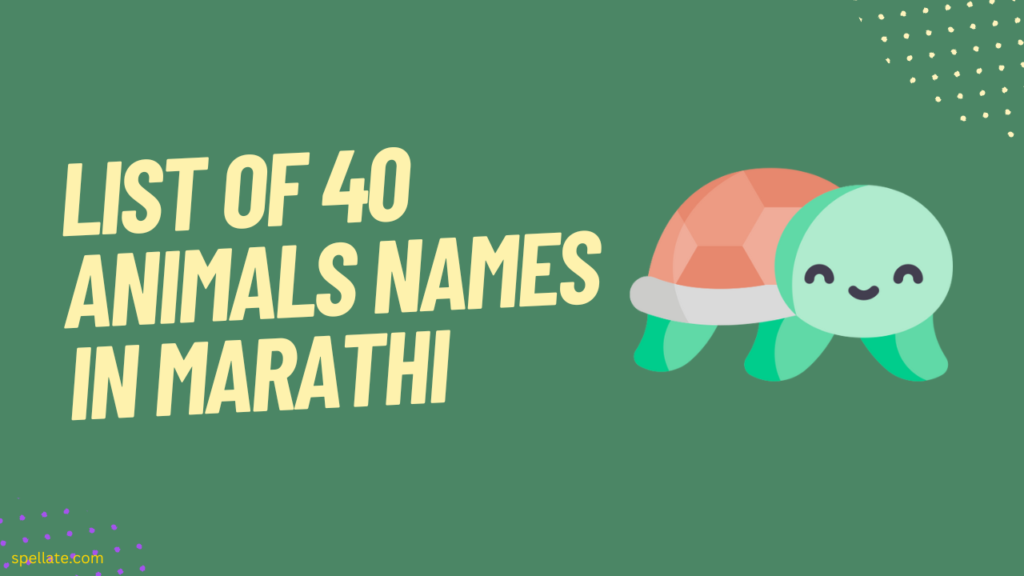
The Marathi language boasts an extensive and varied range of animal names. Certain animals are labeled with simple names, while others possess distinctive and captivating ones. For instance, were you aware that the term मुसुंब denotes a ‘bat’ in English? It is truly intriguing how languages exhibit their own peculiarities when it comes to naming creatures. Acquiring knowledge of these animal names in Marathi unveils an entirely fresh realm of comprehension and admiration for the cultural diversity inherent in languages. Presented below is a compilation of 40 animals name in Marathi and English:
| No | Animals Name in English | Animals Name in Marathi |
| 1 | Tiger | वाघ (Vagh) |
| 2 | Lion | सिंह (Singh) |
| 3 | Elephant | हत्ती (Hatti) |
| 4 | Deer | हिरन (Hiran) |
| 5 | Monkey | माकड (Makad) |
| 6 | Cow | गाय (Gay) |
| 7 | Dog | कुत्रा (Kutra) |
| 8 | Cat | मांजर (Manjar) |
| 9 | Horse | घोडा (Ghoda) |
| 10 | Peacock | मोर (Mor) |
| 11 | Crocodile | मगर (Magar) |
| 12 | Buffalo | म्हैस (Mhais) |
| 13 | Rabbit | ससा (Sasa) |
| 14 | Snake | साप (Sap) |
| 15 | Bear | अस्वल (Aswal) |
| 16 | Fox | लोमडी (Lomdi) |
| 17 | Camel | उंट (Unt) |
| 18 | Rhinoceros | गेंडा (Genda) |
| 19 | Giraffe | जिराफ (Jiraf) |
| 20 | Zebra | झेब्रा (Zebra) |
| 21 | Kangaroo | कंगारू (Kangaroo) |
| 22 | Gorilla | गोरिला (Gorilla) |
| 23 | Polar Bear | पोलार बेअर (Polar Bear) |
| 24 | Cheetah | चीता (Cheetah) |
| 25 | Leopard | चित्ता (Chitta) |
| 26 | Koala | कोआला (Koala) |
| 27 | Whale | व्हेल (Whale) |
| 28 | Crocodile | मगर (Magar) |
| 29 | Tortoise | कछुआ (Kachhua) |
| 30 | Frog | मेंढक (Menhak) |
| 31 | Ostrich | शहामृग (Shahamrig) |
| 32 | Peacock | मोर (Mor) |
| 33 | Vulture | गिध (Gidh) |
| 34 | Eagle | गरुड (Garud) |
| 35 | Pigeon | कबूतर (Kabutar) |
| 36 | Crow | कावळा (Kawla) |
| 37 | Swan | हंस (Hans) |
| 38 | Owl | घुबड (Ghubad) |
| 39 | Woodpecker | काठीमुर्गा (Kathimurga) |
| 40 | Kingfisher | बगळा (Bagla) |
| 41 | Scorpion | वाढवान (Vadhavan) |
| 42 | Mosquito | मासाळ (Masal) |
| 43 | Lizard | उडीद (Uddid) |
| 44 | Grass Snake | धरण्यासाप (Dharnyasap) |
| 45 | Crab | केकडा (Kekda) |
Importance of animals in Marathi culture
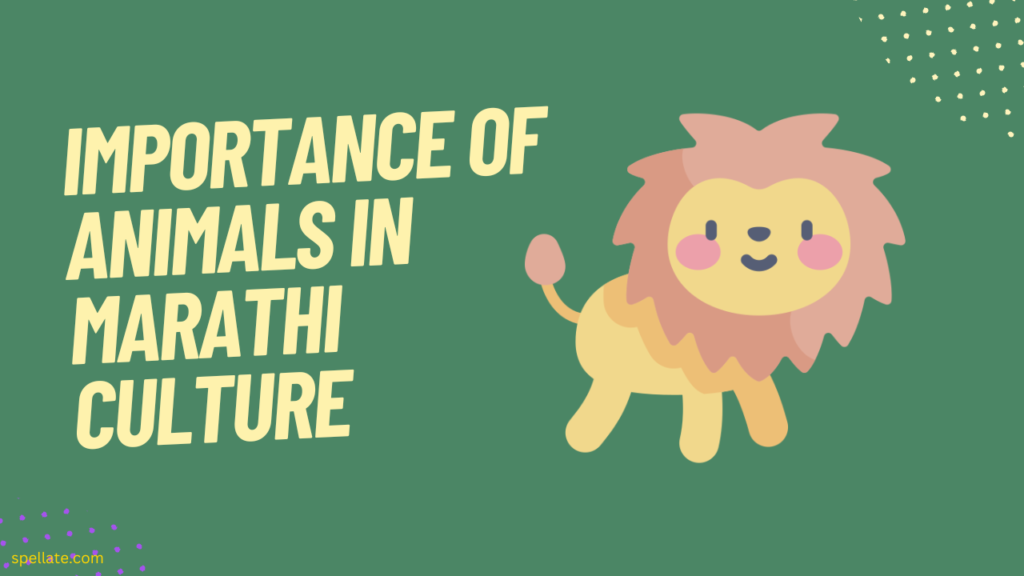
In Marathi culture, animals hold a significant place and play various roles that go beyond utility. They are seen as divine manifestations and have deep spiritual significance. The cow, for instance, is considered sacred and revered as the mother of all creatures. It is believed that treating cows with respect and kindness brings blessings to one’s family.
Another animal of great importance in Marathi culture is the peacock. Known for its vibrant feathers and graceful dancing, the peacock symbolizes beauty, royalty, and good fortune. In Maharashtra, it is believed that having a pair of peacocks on one’s property brings prosperity and happiness. People often adorn their homes with paintings or sculptures of peacocks to attract positive energy.
Furthermore, snakes are regarded with reverence due to their association with Lord Shiva in Hindu mythology. Nag Panchami is a festival dedicated to worshiping snakes where people offer milk as a gesture of respect towards these creatures. Snakes hold symbolic significance representing fertility and protection against evil forces.
Animals Marathi names hold immense cultural value in Marathi society, serving not only as sources of livelihood but also as embodiments of spirituality and symbols of prosperity. Their presence reflects the close bond humans have developed over centuries with these creatures – recognizing them as integral parts of their lives while embracing their unique qualities within the rich tapestry of Marathi traditions and beliefs.
Challenges in translating animals name to Marathi
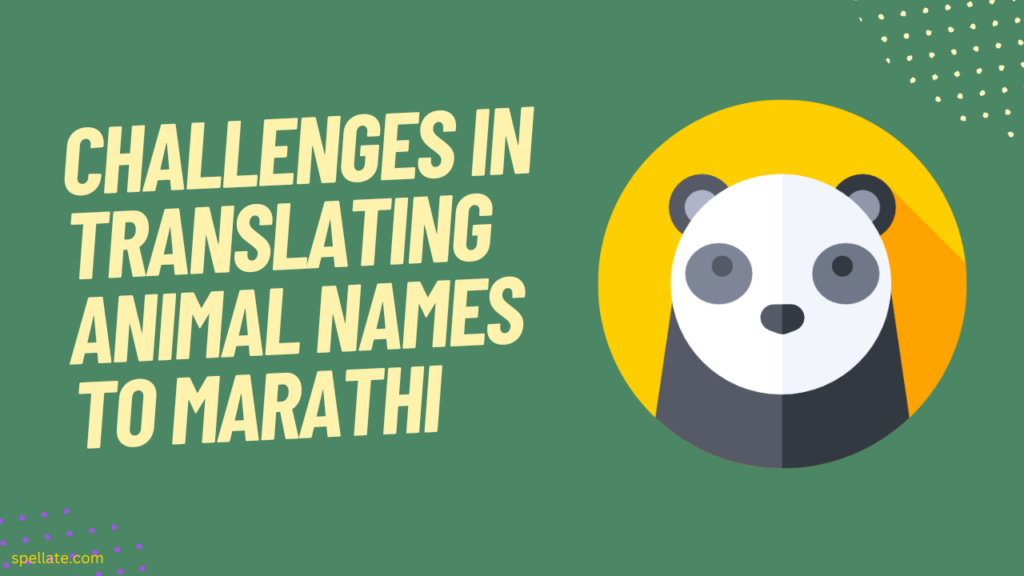
Translating animal names from one language to another can present several challenges, and Marathi is no exception. Here are some of the challenges faced when translating animals name in Marathi:
Regional Variations: Different regions within Maharashtra may have their own unique names for certain animals. Translators need to consider these regional variations and choose the most widely understood and accepted term.
Linguistic Nuances: Certain animals name in Marathi may have linguistic nuances that are difficult to capture in translation. For example, specific animal names in English may have cultural or historical connotations that do not directly translate to Marathi.
Different Ecosystems: Some animals may not be native to Maharashtra, and thus, there may not be an exact equivalent term in Marathi. In such cases, translators may use descriptive phrases or borrow terms from other Indian languages.
Figurative Expressions: Animals name in Marathi are often used in idiomatic expressions, proverbs, and metaphors. Translating these expressions while retaining their intended meanings and cultural significance can be challenging.
Cultural Relevance: Some animals have strong cultural associations in a particular language, but those associations may not be as prevalent or meaningful in another language. Finding equivalent animals with similar cultural significance can be difficult.
Language Structure: English and Marathi have different sentence structures and grammar rules. Translating animal names in the context of sentences while maintaining proper syntax and grammar can be tricky.
Lack of Direct Equivalents: Certain animals may not have direct equivalents in Marathi due to differences in fauna or cultural context. Translators may need to use descriptive terms to convey the meaning effectively.
Sound Symbolism: Animal names often have onomatopoeic or sound symbolic elements that may not be directly translatable, making it challenging to preserve the same auditory effect in Marathi.
Final Thoughts
In conclusion, learning the names of animals in Marathi can be a fun and enriching experience. It not only allows us to expand our vocabulary but also deepens our connection with the natural world around us. By familiarizing ourselves with these names, we can better appreciate the diversity and beauty of Maharashtra’s wildlife. So why wait? Start exploring the fascinating world of Marathi animal names today and let your love for nature grow stronger than ever before. Happy learning!
FAQs
How do you say a bird in Marathi?
The Marathi word for bird is पक्षी (pakshi).
What is the common term used for fish in Marathi?
Fish are commonly referred to as मासे (mase) in Marathi.
How can I learn more about animals name in Marathi?
You can explore Marathi language resources, books, or online platforms that offer vocabulary lessons or information about animals. There are also Marathi-English dictionaries available that can help you in building your animal vocabulary.
